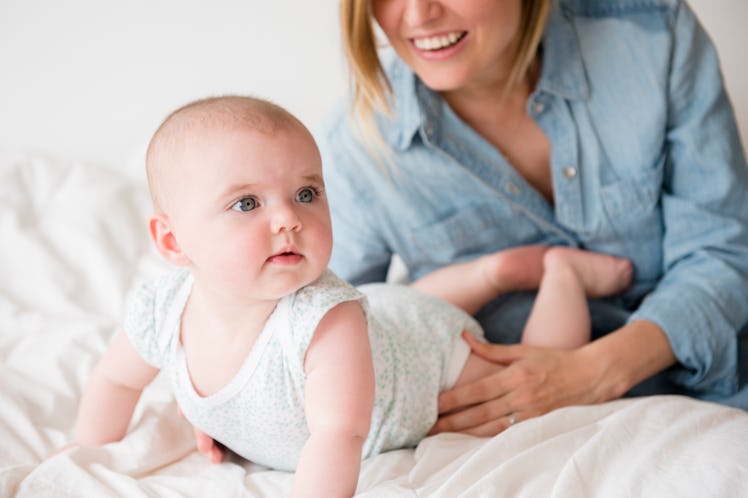4 Baby Exercises That Help Infants Build Strength Safely
Newborns aren’t really known for their raw, explosive power. But when they hit six months, it’s time for baby exercises so they can have better motor development.

Whether a parent is a champion powerlifter or the proud owner of a dad bod, it’s a great idea to introduce a baby to the benefits of exercise early on. That said, though physical activity in infants has far-reaching rewards, for the first six months babies can’t really support their own heads. No amount of weighted chin tucks or barbell neck bridges are going to beat nature here, so it’s best to wait until the baby can lift the ol’ dome before beginning baby exercises. So press pause on the newborn exercises, but baby exercises are probably fine starting around 6 months old — and could hold great benefits.
“The more physical activity that you can do with an infant, the more opportunities the infant will have to develop a strong foundation of physical skills,” says Stephen Sanders, Ed.D., professor in the College of Education at the University of South Florida and author of Encouraging Physical Activity in Infants. “Children learn about their bodies and environment by moving, and the more they can be physically active, the better.”
For infants, movement and exploration are essential for building a strong foundation for childhood and beyond. “What we know from research is that infants and toddlers who develop a strong base of motor skills tend to use those skills to be physically active as adults,” Sanders says. “Children who do not acquire these motor skills will likely experience difficulty in engagement in physical activity throughout life.”
There is reciprocity between physical activity and motor skills. As the competency of an infant’s motor skills increase, Sanders says, so does their increased participation in activity. That increased participation feeds back into increasingly developed motor skills. This is all interlinked with other critical functions such as hearing, vision, and spatial perception — all of which benefit from frequent and repeated practice.
In fact, this physical activity influences a baby’s development in ways that aren’t immediately apparent. Research shows that these early experiences shape a child’s future in myriad ways beyond physical strength, showing evidence of cognitive, social, and perceptual development. And an ability to balance can also be correlated with increased aptitude in heady academic subjects like math.
4 Baby Exercises for Strength and Balance
One of the first things parents can do with a baby is to start off with a bit of tummy time. When the baby is ready, roll them on to their stomach. “When an infant can hold her head up without assistance from an adult, they are ready to be placed on their stomach for play,” Sanders says, adding that this has measurable benefits for physical development. “Infants who are placed frequently in the prone position on their stomachs score higher on measures of motor development. Infants who spend more waking hours on their backs may actually experience motor delays.”
Workout sessions for infants should focus on balance and strength. Parents can use their own body to support their baby, gradually increasing the kid’s reliance on their own muscles by gently placing them off-balance. This can involve daily activities in which parents put their baby in an unbalanced position where they must right themselves using their own motor skills and strength. “Infants who are learning to sit up can be held from behind, sitting on the parent’s lap, so they can be leaned one way or the other,” Sanders says. “This encourages them to tighten their muscles to remain on-balance.”
Another way to get a baby to practice balance is to hold them high up on the parent’s shoulder. With less of dad to hold on to for support, the kid will rely on their own strength to support themselves and to look around at the world.
When the kid is ready, parents can also introduce objects to help them strengthen their grip and improve dexterity. “Strength activities, where an infant practices grasping objects, are good for young infants,” Sanders says.
But remember: Neck strength must be developed enough before exploring any of these baby exercises, Sanders says.
This article was originally published on